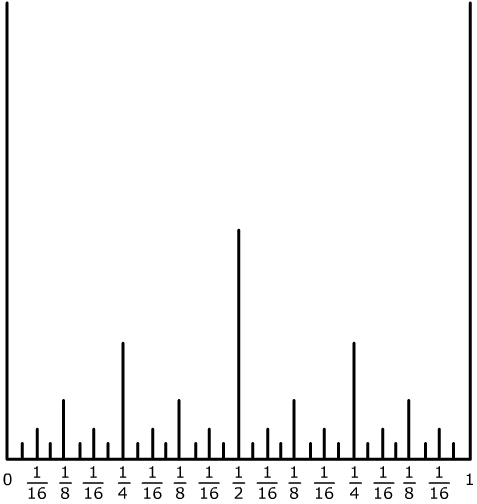Copyright © University of Cambridge. All rights reserved.
'Ruler' printed from https://nrich.maths.org/
Show menu
Andaleeb sent in this excellent solution.
The diagram shows some of the vertical lines drawn for values of x between 0 and 1 as described in the question. The lines are of height 1 unit at x = 0 and 1, of height ${1\over 2}$ units at $x= {1\over 2}$ , of height ${1\over 4}$ units at $x= {k\over 4}$ and ${1\over 8}$ units at $x= {k\over 8}$ and so on... up to ${1\over 2^5}$ at ${k\over 2^5}$ where $k$ is a positive integer.
| n | $0$ | $1$ | $2$ | $3$ | $4$ | $5$ | $6$ | $\dots$ | $n$ | $n+1$ |
| Height | $1$ | ${1\over 2}$ | ${1\over 4 }$ | ${1\over 8}$ | ${1\over 16}$ | ${1\over 32 }$ | ${1\over 64}$ | $\dots$ | ${1\over 2^n}$ | ${1\over 2^{n+1`}}$ |
| Lines cut | $2$ | $1$ | $2$ | $4$ | $8$ | $16$ | $32$ |
$\dots$
|
$2^{n-1}$ | $ 2^n$ |

Thus if the height $h$ lies in ${1\over 2^n} > h> {1\over 2^{n+1}}$ then the number of lines cut is given by $$ 2 + 1 + 2 + 4 + 8 + ... + 2^{n-1} = 2 + {{2^n - 1} \over {2 - 1}} = 2^n + 1.$$ As $n$ tends to infinity the height of the lines tends to 0 and the number of lines cut tends to infinity.